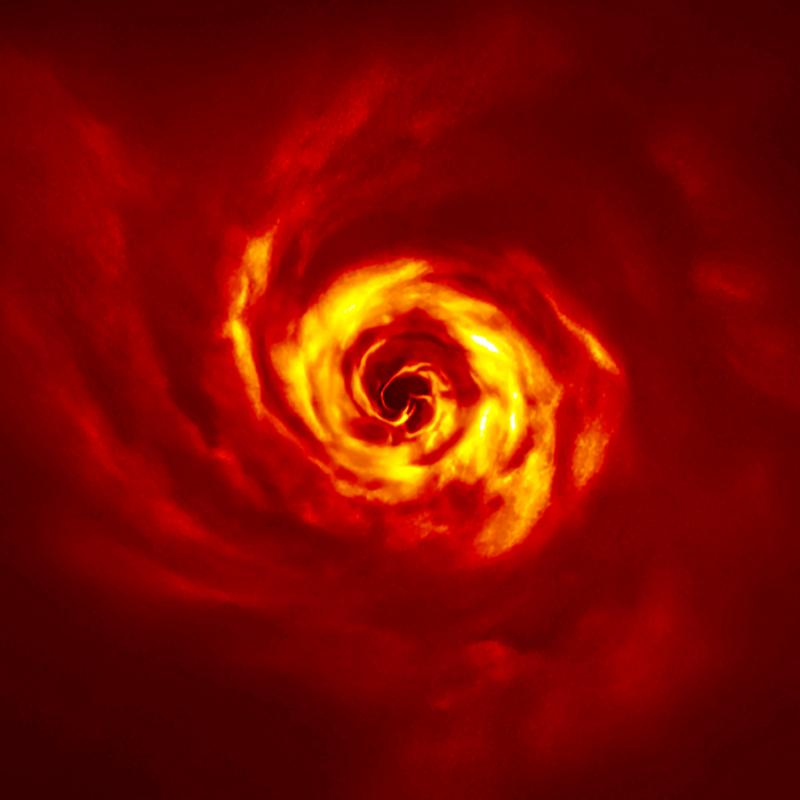Astronomers believe they may have found the first direct evidence of a new planet being born. A dense disc of dust and gas has been spotted surrounding a young star called AB Aurigae, about 520 light years away from Earth.
Using the European Southern Observatory’s (ESO) Very Large Telescope (VLT), located in Chile, the researchers observed a spiral structure with a “twist” near the center, which suggests a new world may be in the process of forming. The swirling disc was one of the telltale signs of the star system being born in the constellation of Auriga, the scientists said.
Anthony Boccaletti, who led the study from the Observatoire de Paris at the PSL University, in France, said: “Thousands of exoplanets have been identified so far, but little is known about how they form.”

Photo: Reuters照片:路透
Boccaletti and his team of astronomers used VLT’s SPHERE instrument — short for Spectro-Polarimetric High-contrast Exoplanet Research — to take photos of AB Aurigae, which show “a stunning spiral of dust” caused by the baby planet trying to “kick” the gas. The same instrument was used in 2018 to take photos of another infant planet, thought to be just 5.4 million years old.
According to Emmanuel Di Folco, of the Astrophysics Laboratory of Bordeaux in France, and one of the study’s authors, this so-called kicking phenomenon causes “disturbances in the disc in the form of a wave, somewhat like the wake of a boat on a lake.”
As the new planet rotates around AB Aurigae, it causes the surrounding gas and dust to be shaped into a spiral arm. The very bright yellow region near the center of the spiral is the twist, which lies at about the same distance from the star as Neptune from the sun.
The Institute of Astronomy and Astrophysics of Academia Sinica (ASIAA) in Taiwan on Wednesday revealed further detail behind the sequence of events that led to this milestone in astronomy. Back in 2017, researchers led by ASIAA Assistant Research Fellow Tang Ya-wen first spotted prominent spiral structures in a dense disk of dust and gas around the young star. They suggested that the site might be the location of a forming planet. In 2019 and early 2020, Boccaletti led a multi-national research team, in which Tang also participated, to conduct the most thorough and comprehensive observation of AB Aurigae to date, using the SPHERE instrument on the ESO’s VLT.
The observation confirmed the presence of the spiral arms, first detected by Tang in 2017, and spotted a very bright yellow “twist” region close to the center of the disk, which suggested that the light came from the accretion of dust and gas at a lower temperature, which conforms with theoretical models of planetary formation. Astronomers believe that planets are born from this kind of accretion of dust and gas surrounding a young star — AB Aurigae in this case — and that this discovery serves as the first direct evidence of baby planets coming into to existence.
“We need to observe very young ‘star-planet’ systems to really capture the moment when planets form. But until now astronomers had rarely been able to take sharp enough images of these young disks to directly discern regions of planetary formation,” Tang says. The observations are reported in the journal Astronomy & Astrophysics.
(Guardian, with additional reporting by staff writer)
天文學家表示,他們可能首次發現新行星正在誕生的直接證據。在距離地球約五百二十光年的年輕恆星「御夫座AB」周圍,天文學家發現一塊由密集的塵埃和氣體形成的圓盤。
研究人員運用歐洲南天天文台(ESO)位於智利的「甚大望遠鏡」,對一個螺旋形天體結構進行觀測,在接近其中心處發現一個「扭結點」,暗示一顆行星可能正處於誕生過程中。科學家表示,這個旋轉的圓盤可說是恆星系統正在御夫星座內形成的典型徵兆。
這項研究來自於法國巴黎文理研究大學的巴黎天文台,研究主持人安東尼‧博卡萊蒂指出:「迄今,人類已經辨識出成千上萬顆系外行星,但是我們對於它們形成的方式卻所知甚少」。
博卡萊蒂和他的天文學家研究團隊利用「甚大望遠鏡」的「SPHERE」行星搜尋器(全名為「光譜偏振高對比系外行星研究儀」),對御夫座AB進行拍攝,影像呈現出一片「驚人的塵埃漩渦」,這是行星寶寶試圖想要「踢」氣體的結果。該儀器在二○一八年也曾被用來拍攝另一顆嬰兒行星,科學家當時推測該行星年齡僅有五百四十萬年。
這篇研究的作者之一、法國波爾多天體物理學實驗室的艾曼紐爾‧迪‧福可表示,這種「踢氣體」現象導致「圓盤內出現波浪狀的擾動,某種程度上像是湖上船隻攪動湖面激起的漣漪。」
當這顆新行星繞著御夫座AB公轉時,它會使周圍的氣體和塵埃形成「旋臂」。在接近螺旋中心處,有一塊非常明亮的黃色區域,就是「扭結」點,其位置與恆星的距離大約跟海王星到太陽的距離相同。
台灣中研院天文及天文物理研究所也在週三透露這項天文里程碑的過程。二○一七年,中研院天文所湯雅雯助研究員率領的研究團隊,曾在這顆恆星周圍的稠密氣體塵埃盤中,首度窺見到顯著的旋臂特徵,認為那可能就是行星正在形成的位置。去年及今年初,博卡萊蒂率領成員包含湯雅雯在內的跨國團隊,利用ESO的「甚大望遠鏡」對御夫座AB星做了迄今最深入的一次觀測。
觀測結果確認二○一七年湯雅雯觀測到的確實是旋臂特徵,並且在接近圓盤中心處,發現非常明亮的黃色「扭曲」區塊,暗示出溫度較低的氣體和塵埃在此結成團塊,符合行星誕生的理論模型。天文學家推測,行星的誕生來自於圍繞年輕恆星(例如這次的御夫座AB)的塵埃盤中,氣體和塵埃會聚在一起的結果。因此,這項發現可說是新生行星正在誕生中的直接證據。
湯雅雯表示:「要抓住行星誕生的剎那,必須要觀測很年輕的『恆星-行星系統』。如果能取得這類新生星盤的銳利深入影像,就可直接辨別哪裡是行星形成的地方,但目前為止天文學家很少能取得那樣犀利的影像。」這份觀察結果日前發表於期刊《天文與天體物理學報》。
(台北時報章厚明編譯)

A: What’s the theme of the 2025 Taiwan Lantern Festival’s main lantern? B: The theme is “Paradise,” and the main lantern is a snake-shaped “infinity” symbol that features a lighting show every half an hour. A: Cool, I heard that there are over 300 lanterns. B: There are even giant lanterns in the shape of Pikachu and some other popular Pokemon characters. A: Let’s go now. A: 2025台灣燈會主燈的主題是什麼? B: 主題是「無限樂園」!主燈的造型則是蛇形的數學「無限號」,主燈每半小時還有一次燈光秀。 A: 酷喔,聽說總共有300多件花燈作品。 B: 甚至還有皮卡丘和其他熱門寶可夢角色的巨型花燈呢。 A: 哇我們現在就出發吧! (By Eddy Chang, Taipei Times/台北時報張聖恩)

After steel and aluminum, US President Donald Trump has set his sights on slapping 25 percent tariffs on semiconductors, cars and pharmaceuticals. Trump has already slapped additional 10 percent tariffs on goods from China and has also threatened tariffs on Canada and Mexico, plus ordered a study into putting into place reciprocal tariffs. Here’s a look who would be hit the hardest if US import tariffs on semiconductors, cars and pharmaceuticals go into force. SEMICONDUCTORS: ASIA IN THE CROSSHAIRS Semiconductors, or microchips, are the brains in our electronic devices and demand has soared with the development of AI, which

本文由生成式AI協作,本刊編輯編修。 Tucked away in southwestern Taiwan, Yunlin County is a treasure trove of cultural heritage, rich history, and natural beauty. From its stunning temples and glove puppetry to historical architecture and picturesque landscapes, Yunlin rewards those who venture off the beaten path. Yunlin is renowned for its flourishing temple culture. Temples in this region are not merely places of worship but also communal centers where people gather for festivals, rituals, and social functions. One of the most notable temples here is the Beigang Chaotian Temple, which was built more than 300 years ago and is dedicated to Matsu, the sea

Nestled within the heart of Taipei, National Taiwan University (NTU) contains a grand and spacious sanctuary where nature and academia come together in perfect accord. Across its expansive 111-hectare campus, NTU reveals a landscape rich with history, lush greenery, and a thoughtfully preserved ecosystem. This tranquil haven invites visitors to take their time wandering among the elegant buildings, to admire the rare plants, and to experience a space that exudes quiet inspiration. Zhoushan Road: A Gentle Prelude to NTU’s Tranquility Beginning at Gongguan MRT Station, the enchanting avenue Zhoushan Road leads visitors into NTU shaded by golden rain trees, cottonwoods, and Javanese